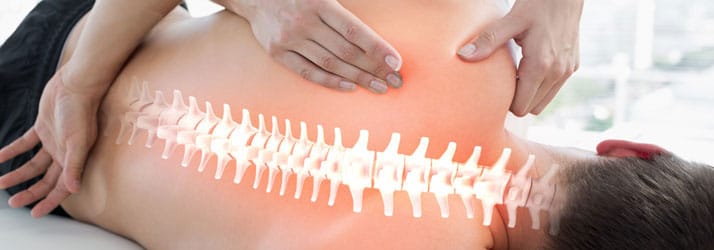All About Spinal Decompression

All About Spinal Decompression

Updated on August 20th, 2019 by Dr. Ryan Meehan
If you have had back pain, you know how disabling and disruptive is can be to your life. Back pain is the leading cause of disability, not just in the U.S., but worldwide. The structure of the back is complex and there is a lot that can go wrong there. Spinal decompression therapy treats many conditions that can cause pain in the back and neck. What is spinal decompression therapy?
WHAT IS CAUSING YOUR BACK PAIN?
Osteoarthritis is a common cause of back pain. Between each vertebra in the spinal column is a cushion called a disc. The discs keep the bones from hitting together as you move and, and, without them, you would feel a jolt every time you took a step. Over time, the discs can wear down due to aging or trauma. This degeneration allows the edges of the vertebrae to pull closer together and, possibly pinch a nerve.
Other conditions that can cause pinching include:
- Facet joint degeneration
- Facet joint hypertrophy
- Ligamentous hypertrophy
- Spondylolisthesis
Sometimes there is more than one problem causing you pain.
Symptoms of a compressed spine include:
- Pain in the back or neck
- Numbness in the extremities
- Tingling in the extremities
- Weakness
Whatever is leading to the pinched nerve, spinal decompression therapy may offer relief.
WHAT IS SPINAL DECOMPRESSION THERAPY?
Spinal decompression or traction therapy is a nonsurgical treatment for what most people call a “pinched nerve.” Pinching occurs as the nerve exits the spinal column. Many conditions can cause this, but it is most associated with degenerative disc disease.
HOW DOES SPINAL DECOMPRESSION THERAPY WORK?
Spinal decompression therapy stretches the spine very gently. The stretching lifts the bones and takes the pressure off the discs. Older or damaged discs can bulge. The stretching therapy may allow the bulging to retract, as well, At the same time, the lifting allows water, oxygen and nutrients to get to that part of the spine helping the discs to heal.
HOW IS SPINAL DECOMPRESSION THERAPY DONE?
The chiropractor uses a special table for this treatment. The patient lies down on the table, either face up or face down. A harness goes around the hips and another around the trunk just under the armpits. A computer controls the stretching based on each person's needs.
Spinal decompression therapy is sometimes done in adjunct with other treatment such as:
- Electrical stimulation - The use of a mild electrical current to stimulate muscle contractions
- Ultrasound - The use of sound waves to create heat that relieves inflammation
- Heat or cold therapy
Your spinal decompression therapist might suggest you have these treatments immediately before or after the traction. There may also be some home care needed after the therapy like regular exercise or icing your back.
IS SPINAL DECOMPRESSION THERAPY JUST FOR BACK PAIN?
It also works well for those with cervical pain or neck pain. Nerves pinched in the upper region of the spine may cause neck discomfort and stiffness.
HOW LONG DOES THE TREATMENT LAST?
That will vary based on the provider and the patient’s condition. You can expect to be on the table for 9 to 15 minutes. If time is a concern, ask the therapist for an estimate.
HOW MANY TREATMENTS ARE NECESSARY?
You should feel some relief right away. Most patients require 20 to 28 treatments over about two months for lasting help.
IS SPINAL DECOMPRESSION THERAPY SAFE?
Studies indicate that spinal decompression is safe. The procedure is tightly controlled to ensure the patient's safety. It may not be the right choice for everyone, though. It is not recommended for those with:
- A broken vertebrae
- Spinal fusion
- An artificial disc or metal spinal implant
- A tumor on the spine
- Abdominal aortic aneurysm
- Advanced osteoporosis
- Bone cancer
It is also not a consideration for anyone who has had multiple back surgeries or a failed procedure. There is some question whether is acceptable for a woman who is pregnant. Tell your spinal decompression chiropractor if you are expecting a baby.
IS SPINAL DECOMPRESSION THERAPY A TYPE OF SURGERY?
No, this is a nonsurgical approach to treating back pain. There are several kinds of spinal decompression surgeries, though, and it is easy to confuse the two. Traction therapy is noninvasive.
WHAT ARE THE ALTERNATIVES TO SPINAL DECOMPRESSION THERAPY?
Surgery is one common alternative to traction therapy. Ideally, that should be a last resort, though. Other treatment options might include:
- NSAIDs - Over the counter anti-inflammatories such as Aleve or naproxen sodium
- Physical therapy
- Steroid injections
- Back or neck brace
- Chiropractic adjustment
IS SPINAL DECOMPRESSION THERAPY COVERED BY INSURANCE?
It will depend on the policy and the provider. It is generally covered by workers compensation but not all private insurance companies offer this benefit. Contact your insurance provider to find out if traction is covered under your policy.
WHAT IS HOME SPINAL DECOMPRESSION?
Home spinal decompression is a series of stretching exercises that can include dangling from a bar, yoga positions like the Child’s Pose and cat-cow stretch or using an inversion table that allows you to hang upside down to stretch your spine. The chiropractor may suggest you do these as part of your overall treatment plan.
If you experience chronic neck or back pain, call our office at (330) 920-1681 or fill out our online contact form and we will call you. We are happy to make an appointment for you to discuss spinal decompression therapy with one of our chiropractic experts.

